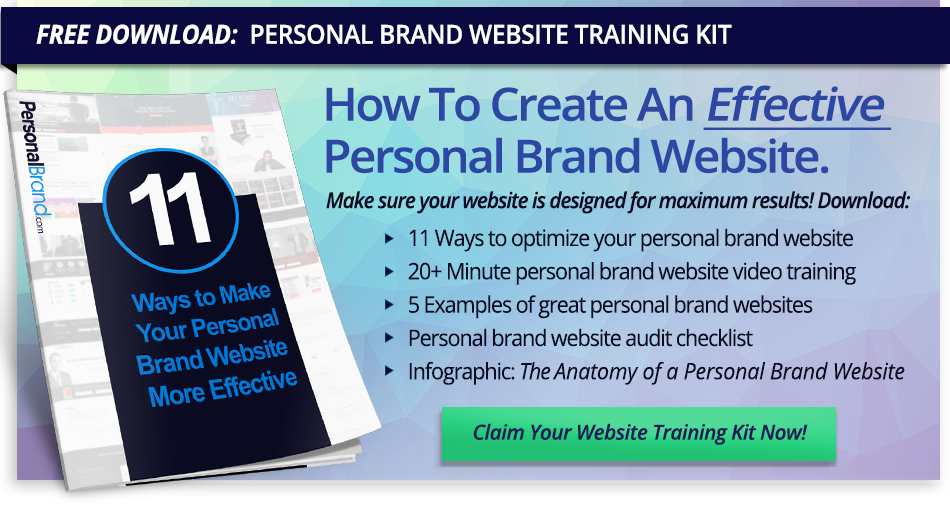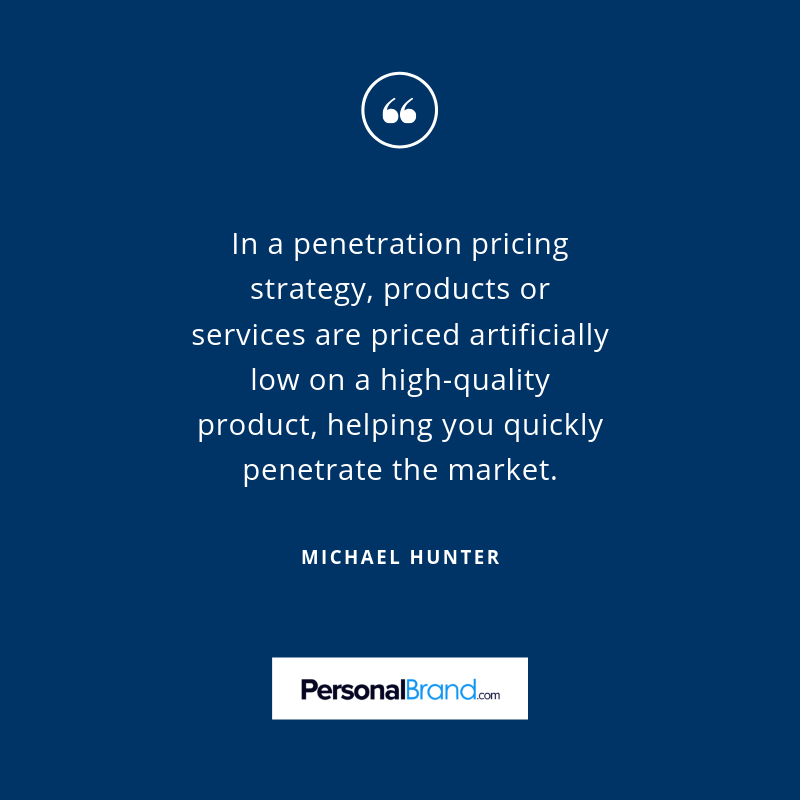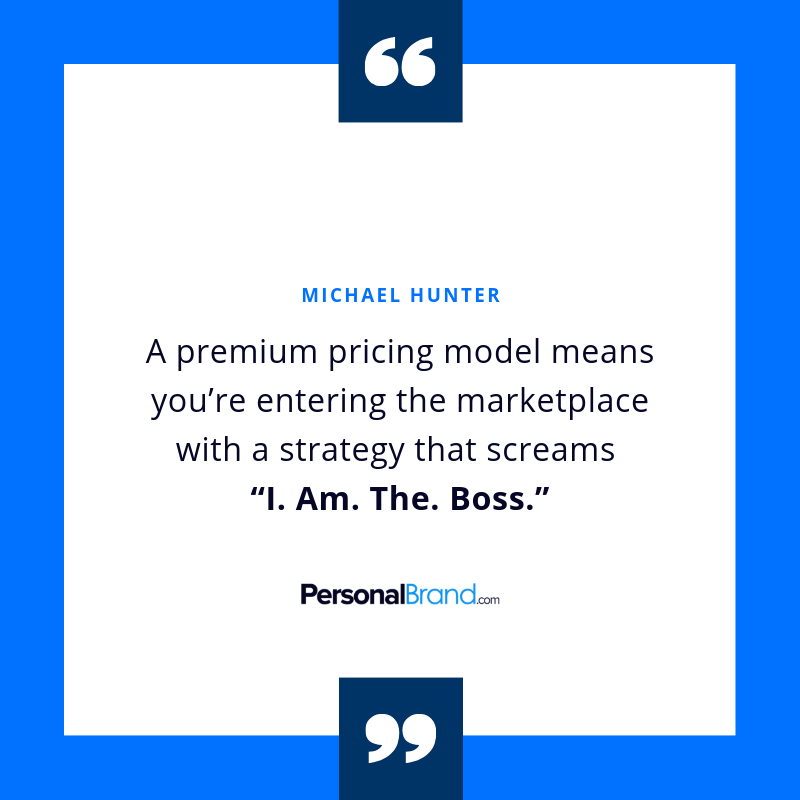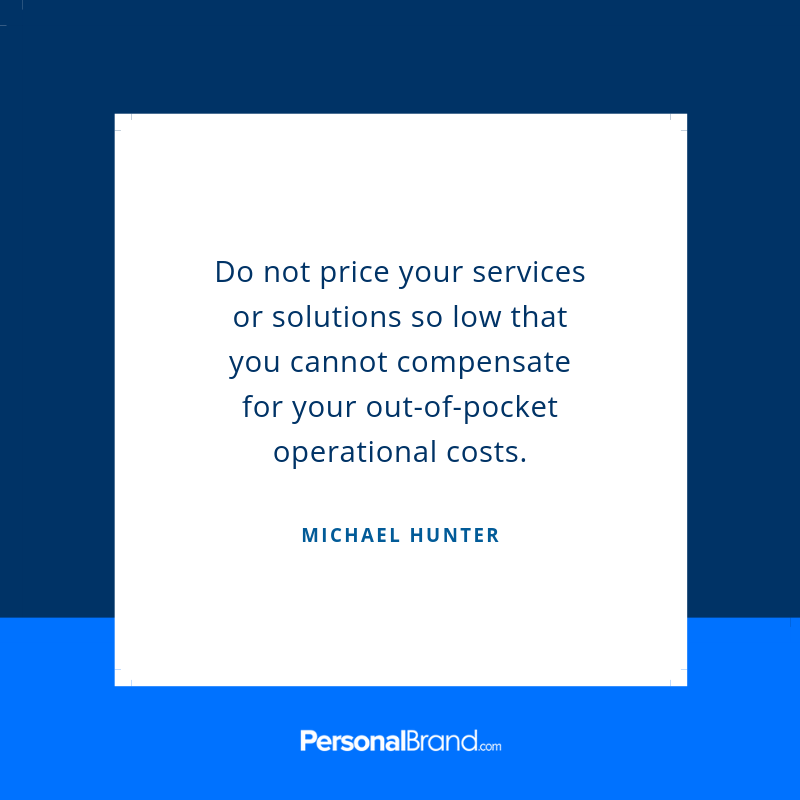How to Get Paid What You’re Worth: Pricing Tips for Your Personal Brand
It’s a challenge that all entrepreneurs, solopreneurs and start-up organizations must face: how to get paid what you’re worth. Pricing is a significant factor in building your personal brand.
In the nascent days of your business and the development of your personal brand, the challenge is possibly at its peak. Without an impressive portfolio of clients and experience, how can you charge the higher rates you know you deserve?
At the same time, do you dilute your brand name and your value in the marketplace if you underprice your services? That’d make it harder in the future to attract your ideal, higher-paying prospect.
It’s a conundrum, but you can overcome it with strategic planning, a robust sales strategy, and a commitment to earning what you’re worth. We’re going to prove it to you.
What is Pricing Strategy?
There are formulas and methodologies that you can follow to help you effectively set your pricing to achieve a positive return on investment (ROI). We’re talking about pricing strategies.
Typically, the factors you should consider when establishing your pricing strategy include:
- Target customer
- Personal brand objectives
- Short and long-term business objectives
- Competition
- Position in the marketplace
- Ongoing operating expenses
You may still feel like there’s a lot to consider, and you’re not sure how to weigh each factor.
In this post, we’ll provide you with the pricing strategy matrix. It’s a tool that helps you evaluate the factors above to establish your pricing strategy.
The four quadrants in the matrix above indicate four different strategies for pricing products at the intersecting continuums of price and quality. Let’s consider each quadrant.
Economy Pricing: Low Price + Low Quality
It makes sense that you don’t want to offer people a low-quality service.
Just know that when we talk about quality, we are focusing on your overhead costs.
If you provide consulting services, and the only tools you need to do it are your cell phone and laptop, your overhead is relatively low. Compare that to someone who hosts week-long, off-site C-Suite training sessions that require costs like venue rental, meals, printed handouts, and transportation costs.
Do not price your services or solutions so low that you cannot compensate for your out-of-pocket operational costs.
Similarly, do not pursue an economy pricing strategy unless you have lower overhead costs than your competitors.
For example, maybe you offer video consulting where your primary competitors offer off-site consulting. In that scenario, you could effectively come in with lower costs for services that are just as high quality, putting you in a better position to grab market share.
The Pros of Economy Pricing
- Your business model may be better able to survive a financial recession, depending on your industry.
- You can appeal to a broader range of prospects in need of a more affordable solution.
- You can gain market share by offering a lower cost for a quality service.
The Cons of Economy Pricing
- Even with lower overhead costs, you’ll need a higher quantity of sales to experience long-term sustainability.
- You risk being lower cut by a new entry into the marketplace and losing market share among those clients shopping on price alone. That means that it’s crucial to develop relationships with your clients and offer services with a value beyond price.
- You may decide to increase costs in order to scale your services. For example, you may add an on-site consulting offer or increase your prices to accommodate office space). When you do that, you risk alienating your existing clients who have taken advantage of your lower costs in the past.
- In a personal brand, where you are selling your time in the form of your services, too high of a sales volume may be unsustainable. That is, until we can find ways to add more hours to the day.
Price Skimming = Low Quality + High Price
Not an approach for the faint of heart, this pricing strategy requires a bold go-to-market mindset.
This plan aims to hit the ground running with fewer customers who are able and willing to pay higher costs for your services or solutions until you’re ready to broaden your target audience and move to more commoditized pricing.
When you make that move, you will be skimming profits from a broader, more price-conscientious market segment. If executed well, you will generate ample revenue initially to cover your operating costs and then some. That leaves you with earnings that can be used to create and implement a marketing plan when you’re ready to expand.
The Pros of Price Skimming Pricing
Price skimming can be impactful in a market that values new, innovative solutions. If you are coming into the market, for example, with the secret to diet-free, safe, weight-loss, your early adopters will pay for it at a premium.
Compared to other pricing models, price skimming will best enable you to cover your overhead and startup costs quickly.
The Cons of Price Skimming Pricing
You risk alienating your early adopters when you eventually drop your prices.
You will want to differentiate your offering when you do decide to drop your prices, which will mean some service and solution strategy work.
For example, to avoid disappointing your early customers who paid a higher cost for your 60-day diet plan, perhaps you’ll need to create and promote a 30-day weight-loss guide and establish it as the core of your offering.
There is a finite tipping point when the market and your target audience will no longer sustain your higher prices. Overshooting that point could hurt your scaling and growth strategy long-term.
Penetration Pricing: Low Price + High Quality
We’re about to hit you up with the key message in this very first sentence: Penetration pricing is not a sustainable long-term strategy.
Only use it to introduce your services to the market to gain the attention of prospects, get them in the door, and build long-term relationships on factors other than price.
In a penetration pricing strategy, products or services are priced initially artificially low on a high-quality product. This helps you quickly penetrate the market.
Understand, however, that this means you will not necessarily recoup your costs during this limited time offer period, no matter how many customers you take in.
As an example of penetration pricing, perhaps you are a life coach. For a limited time, at the launch of your new 60-day coaching plan, you offer 50% off for first-time customers.
During this time, it is critical to convert as many of your introductory offer clients into repeat customers as possible. That, or at least gain valuable referrals from them so that your prospect pool doesn’t dry up when your special offer runs its course.
The Pros of Penetration Pricing
- This pricing helps you gain market share rapidly in a price-driven industry. Why? Because you’re leveraging a price elasticity strategy against more established competitors until you have built up a sizable portfolio and have filled your pipeline with prospects.
- You can more quickly achieve economies of scale by offering a limited-time sale that quickly ramps up your current project portfolio.
The Cons of Penetration Pricing
- If you offer your promotional rate for too long or don’t have enough buyers at your non-promotional prices, you could struggle to earn positive ROI long-term.
- If you undercut your pricing too much initially, you could be misperceived in the marketplace as not offering a high-quality product or service.
- You may lose (or fail to retain) customers when your promotional period ends.
Premium Pricing: High Quality + High Costs
As its name implies, a premium pricing model means you’re entering the marketplace with a strategy that screams “I. Am. The. Boss.”
This approach is a challenging position to take unless you already have an established personal brand reputation or significant previous experience from which to draw.
For example, if you’re an established software expert (with a track record of launching and selling a successful and well-known app, you’d be primed for premium pricing.
Once you establish yourself and demonstrate results, and you’re ready to use what you learned to coach other entrepreneurs, your reputation will precede you.
From there, you can enter the market with a premium pricing strategy, knowing your target audience will pay a premium to learn from such a reputable business strategist.
There are two other conditions within which you may want to consider premium pricing. For one, if you have significantly high overhead, you may want to consider it. Also, if you are launching a prestigious service or solution that you intend to market to aspirational shoppers with discretionary income, you may want to consider premium pricing.
The Pros of Premium Pricing
- You have high earning potential because you’re offering a prestigious service or solution.
- You establish your personal brand with the highest possible reputation, and if done correctly, you can set yourself up for long-term sustainability and positive ROI.
The Cons of Premium Pricing
- Depending on your solution and your target audience, you may be marketing to a small market segment—not to mention an audience that can choose to be particular about strategic alignments. Shoppers who have a large amount of discretionary income make this possible.
- Unless you already have a positive reputation and a network of prospects, it is challenging to enter the market with a premium pricing strategy, especially in an already saturated market.
- Competitors that take the economy or skimming pricing approach will be constant threats to your market share.
Scalability, Growth, and the Long-Term Strategy of Pricing
Commitment-phobic entrepreneurs, rejoice! We’re about to tell you that your pricing strategy can be—and should be—fluid.
Conditions are changing constantly. You’re developing new products and services. Your competition changes. The marketplace dynamics change. The needs of your target audience change.
Because of those fluid conditions, you can (and should) reevaluate your services, solutions, and associated pricing.
Remember: you only get one chance to make a first impression. Therefore, the way you position your personal brand and establish your pricing when you first enter the market is critical to early perception of your personal brand.
These growth opportunities may arise in those initial months or years when you’re most in need of recouping your overhead and startup costs.
This aspect takes us back to a critical point from the beginning of this article: You can’t establish your pricing strategy without a deep understanding of the following factors:
Target Customer
Who may benefit from your services or solutions? What problems do they face that your offering solves?
Now go deeper. What do they value in a business partner? In a brand? Are they value-conscious, or do they desire brands and associations that elevate their standing in society?
By understanding your target audience, and what they are willing to pay for your services, you can find the ideal pricing sweet spot. Click here for more insights on building a value proposition that addressed marketplace needs.
Personal Brand Objectives
Now, it’s time for some goal setting.
Where do you want to see your personal brand in five years? How about ten years?
Do you want your brand to earn an elite position in the marketplace, or be accessible to a broad segment of the population?
Your brand objectives have to align with your pricing strategy, and both must align with your marketing strategy. Consider these marketing messaging best practices.
Short and Long-Term Business Objectives
Do you have an arrangement to deliver profitability to your investors in a rapidly approaching period? Can you afford to scale slowly by building your brand, your prospecting pipeline, and your clientele over a period of years?
Are you already starting with a well-established reputation and network?
Knowing how you plan to scale your offering will help you price your personal brand services.
Competition
Put on your jaunty Sherlock Holmes hat, because you can’t possibly know where you stand in the marketplace until you understand your competitors.
That includes their product and service offerings and pricing. If their pricing is not listed in their marketing materials, then you may need to do some sleuthing by talking to their customers to gain some inside scoop.
Bonus Ninja Tactic: If you just skipped the competition section because you think your service and solutions are so innovative that you don’t have competition, then get back here and keep reading.
Everyone has competitors.
Even Elon Musk now has competitors vying to send the first privately-owned space shuttle to outer space.
If you do have an innovative offering with no direct competitors, you may have indirect competitors—someone offering an alternative to your solution that, while not identical, solves their need in an alternative manner.
Ongoing Operating Expenses
Take a deep dive into your accounting software (or use paper and pencil if you must).
Calculate exactly how much it costs you to operate your business every year.
That includes office space, contractors, taxes, transportation, marketing, software subscriptions, your cell phone, office supplies and business-related materials. It even includes that weekly latte you buy for your best client while you catch up on project work.
To achieve positive ROI and business sustainability, you must price your solutions to cover your operating costs.
Don’t tell your high school math teacher that we said this, but pricing is an art and a science.
As someone building a personal brand and selling services, rather than products, you have more flexibility in how you price your offerings. Just make sure you are covering your expenses, giving yourself room to scale, and aligning your pricing with your positioning in the marketplace.
By taking a strategic approach to pricing, you’ll be well-positioned to earn what you deserve for being the expert that you have become.
We hope you enjoyed this article, thanks for reading! Also, follow us on Facebook, and Twitter for updates every time we publish!





